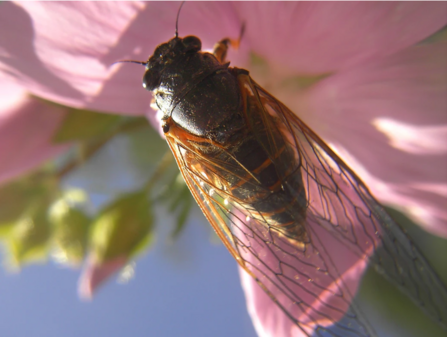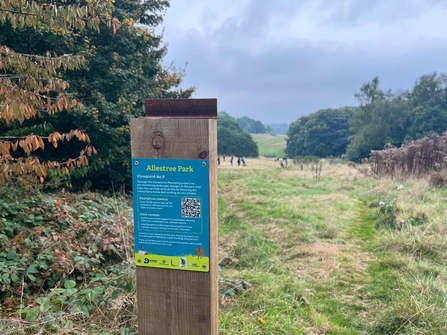Picture this, it’s June 1992 and a 10 year old girl, let’s call her Sarah, hears a high pitched sound when walking with her family in the New Forest. She asks her mum what it could be? Her mum can’t hear it and waves her away. Sarah’s enjoying her walk and decides to find out where the sound is coming from. The rest of her family walk on, leaving Sarah alone in a clearing in the woods. She listens hard, turning her head from side to side to try and find the direction of the sound, which hasn’t stopped. It sounds like air escaping from a pinched hole in a tyre. Eventually, crawling around on her hands and knees, she spots a large, orange and black, clear winged insect. She doesn’t know it, but it’s a New Forest cicada Cicadetta montana. Sarah leaps to her feet and runs after her family to tell them about it.
An Ecological Citizenry

The New Forest cicada (c) The Species Recovery Trust
Unfortunately, they haven’t been heard in the New Forest since the early 1990s and are presumed extinct so the picture that I painted above has been lost for everyone since. And unfortunately it’s not the only lost experience, as can be seen from the most recent State of Nature report (2023). Whilst the New Forest cicada and 150 other species (of the 10,000 species in the UK) have become extinct since 1500, 16% of our species are threatened with extinction, with all species declining by 19% (on average) since 1970. Over the same time period, half of the UK’s plant species have been lost from areas that they were previously found in.
When you read through the headlines in the report, the statistics are bad, but they don’t get across the widespread, almost universal, decline in our natural heritage, which is part of what makes us what we are, our culture. We live in a country which has the lowest levels of nature-connectedness in Europe (2022 study here), as well as being one of the most nature depleted.
These species are nature, as are we, and the web that joins us to them is what allows life on earth to persist. As the connections between species, populations and individuals are broken, fragility for the remaining species, including our own, increases.
In order to restore integrity to the web that supports us, we probably need to reinstate these connections, even it weren’t appropriate to do so morally (the New Forest cicada had every right to exist in its own right).
So let’s do that. Let’s do what we can to bring back these species and restore the web of life which sustains us.
Which is what Species Recovery Trust have decided to do, in partnership with others, with the New Forest cicada. They developed a project, funded by Natural England to reintroduce the species to the UK, using translocated individuals from Slovenia, which has the most sustainable, compatible population to the one in the New Forest. In July 2023, they went to Slovenia to capture, under licence, 10 individuals to bring back to set up a captive breeding population in the UK. All of which is terrific. But, having gone to Slovenia to trap adults, unfortunately they didn’t catch any. It’s very hard! They found suitable larval emergence locations in the summer which identified good locations to trap them the following year but would need to set up the trap to be in place for the following summer, meaning that it needed to be in place over winter. Winters in Slovenia have very heavy snowfall, meaning that the cloth traps are likely to be destroyed. So they needed to be set up after winter, in April, for the whole of the emergence period, which was outside the budget of the project. What to do?
Step in Slovenia’s version of our fictional Sarah, Kristina, whose parents rented the Species Recovery Trust team their accommodation for the survey season. She would set up the trap and monitor it for any emerging adults. The team could then go to Slovenia to collect the adults when they emerged. Problem solved.

(c) David Winslow/Derby City Council
There is an issue with trying to work on a shoestring and, whilst determined people in lots of different organisations are doing great work to bring back species, governments need to do significantly more, and fund significantly more, to bring back the nature that’s been lost, to increase ecosystem resilience as a critical part of addressing the climate and biodiversity crises which are both going in the wrong direction. However, there is an almost limitless need to recover lost species or populations; whilst we need significantly more money to rebuild nature, we also need to do things differently, as there will never be the funding needed to do purely scientist led species reintroductions.
But actually, the cicada project solves another, even bigger problem too, that of disengagement with nature. 12 year old Kristina is now invested in nature’s recovery in the UK. Being a citizen scientist, either through monitoring or photographing sites, counting or raising species for reintroduction (such as undertaken by the Citizen Zoo Hop of Hope initiative) achieves far more engagement with nature’s recovery than reading about it.
At Derbyshire Wildlife Trust we’ve hosted Be a Jay day (planting acorns to mimic the work that jays do in bringing about woodland creation) and Be a Boar day (turning over species poor grasslands to create plant colonisation gaps, mimicking the action of wild boars, a native species which are difficult to reintroduce because of the Dangerous Wild Animals Act). These are actions which benefit nature through reintroducing lost species or lost processes, whilst also addressing the huge issue of nature-disconnectedness.
At our Willington Wetlands site, we introduced beavers to manage reedbeds through natural processes, removing the need for volunteer management. But the number of volunteers on the site has gone up since then, monitoring camera traps, checking fencelines and even running webinars about the beaver programme. Most of which is done independently of DWT (but we do know about it!).
As conservationists, our role into the future should be to help others to be part of the nature recovery story, facilitating and identifying opportunities, rather than needing to do it ourselves. This will need a new skillset, but the web of life that supports us depends on it.

